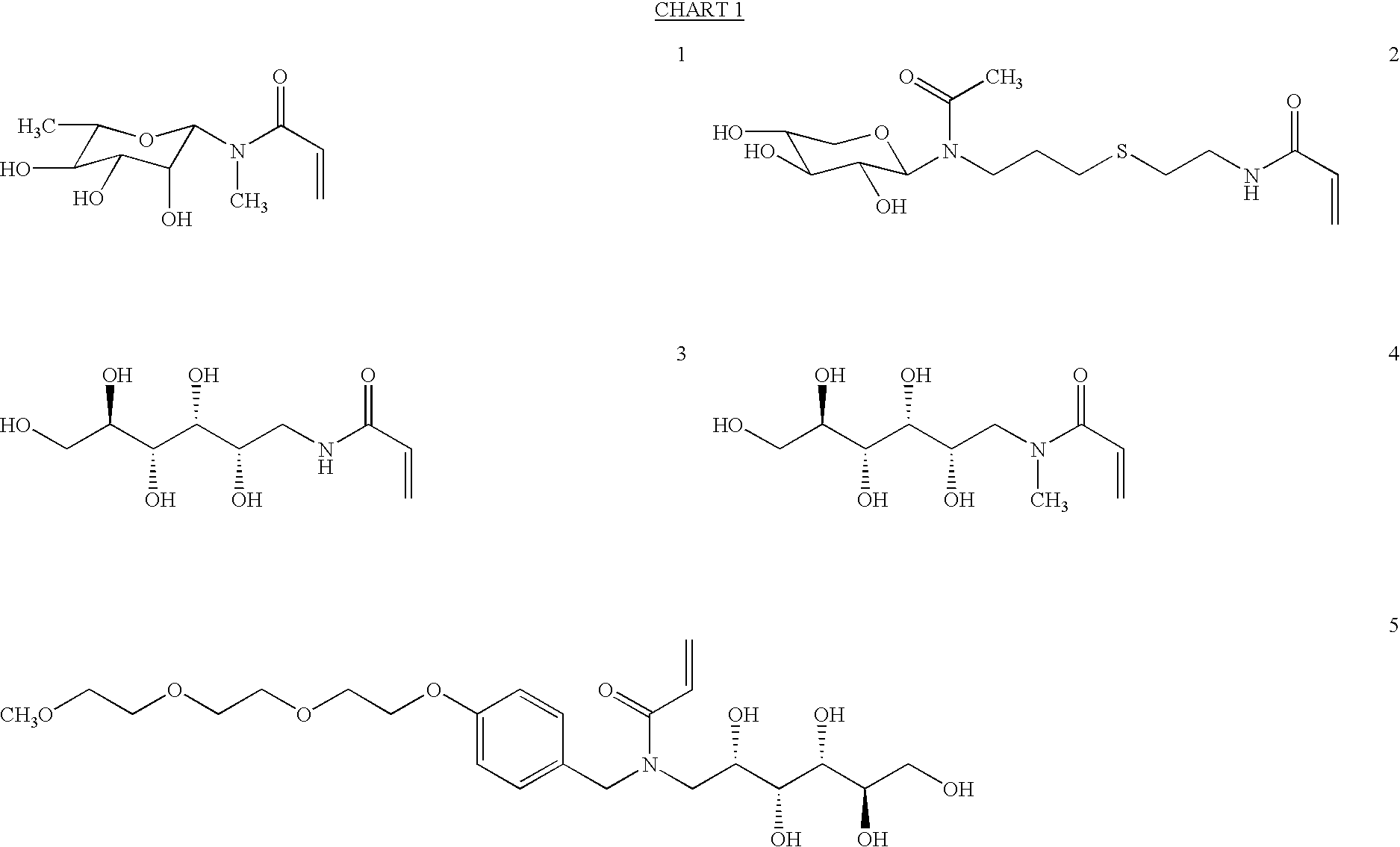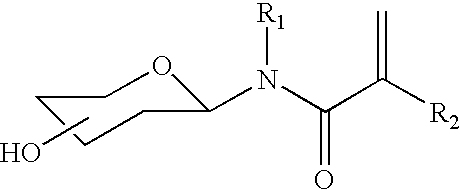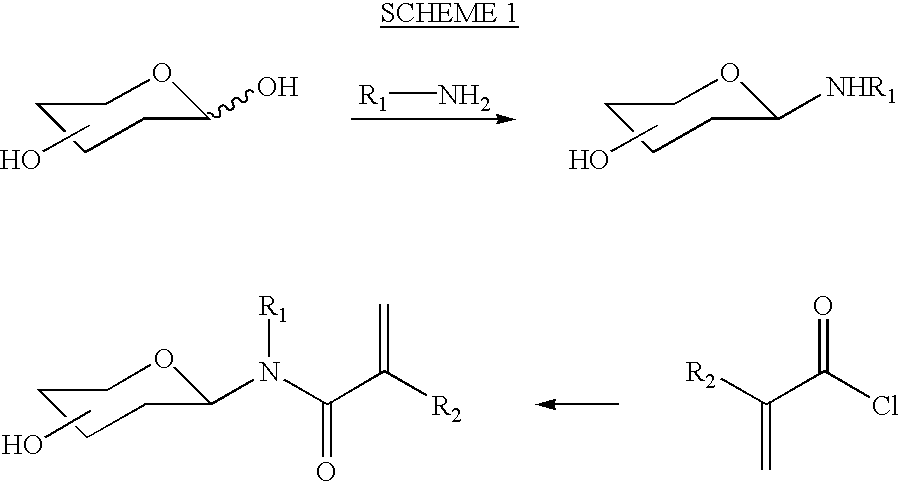Biomimetic hydrogel materials
a technology of biomimetic hydrogel and hydrogel polymer, which is applied in the field of biomimetic hydrogel materials, can solve the problems of low functionality of biomedical applications manufactured by hydrogel polymers
- Summary
- Abstract
- Description
- Claims
- Application Information
AI Technical Summary
Problems solved by technology
Method used
Image
Examples
example 2
N-Methyl-N-.beta.-rhamnosyl Acrylamide (1)
Methylamine hydrochloride (3.8 g, 56.3 mmol) was added slowly to a fresh prepared solution of NaOMe in methanol (100 mL, 1.0 M) and the precipitates were removed by gravity filtration. L-rhamnose monohydrate (5.1 g, 28.0 mmol) was then added and the solution was stirred at room temperature overnight. The reaction mixture was evaporated to dryness to give the light yellow solid intermediate compound 6 which was used for the next step without further purification. To the solid intermediate were slowly added 500 mL of methanol, 30 mL of triethylamine, and a solution of acryloyl chloride in THF (80 mL, 25 wt % vol / vol). The solution was maintained at ambient temperature. The reaction mixture was stirred for 4 hours at room temperature, concentrated in vacuo, and diluted with 100 mL of triethylamine. The precipitated solids were removed by vacuum filtration, and the filtrate was concentrated and purified by silica gel chromatography eluting with ...
example 3
2,3,4,5-Tetra-O-Acetyl-N-Allyl-.beta.-N-Xylosyl Acetamide (7)
For preparation of compound 7, which is an intermediate for preparation of monomer 2, D-xylose (4.0 g, 26.7 mmol) was stirred in allylamine at room temperature for 24 hours. The solution was evaporated in vacuo and the residue was treated with acetic anhydride / pyridine (1:1; vol / vol) overnight. The solution was evaporated to dryness to give 9.3 g (98 wt %) of product compound 7, as slightly colored solid. .sup.1 H NMR (200 MHz, DMSO-d.sub.6, 130.degree. C.) : .delta.5.85-5.64 (m, 1H, --CH.dbd.CH.sub.2), 5.50 (d, 1H, J=9.1 Hz, --OCHN), 5.28 (dd, 1H, J=9.3, 9.5 Hz, --CHOAc), 5.18-4.88 (M, 4H, --CHOAc, .dbd.CH.sub.2), 4.00 (dd, 1H, J=11.5, 6.2 Hz, --CH.sub.2 --), 3.92-3.83 (m, 2H, --CH.sub.2 CH.dbd.CH.sub.2), 3.58 (dd, 1H, J=11.2, 10.7 Hz, --CH.sub.2 --), 2.05 (s, 3H), 1.98 (s, 3H) 1.95 (s, 3H), 1.92 (s, 3H); .sup.13 C NMR (50 MHz, DMSO-d6, 130.degree. C.): .delta.20.02, 21.59, 44.75, 64.19, 68.71, 69.27, 73.23, 83.47, 115.78...
example 4
N-[Allyl-]-.beta.-N-Xylosyl Acetamide (8)
For preparation of the second intermediate for synthesis of monomer 2, compound 7 (9.3 g, 26 mmol) was dissolved in methanol and treated with an aqueous solution of sodium methoxide in methanol until pH 9 was reached. The solution was stirred at room temperature for 4 hours. Dowex resin (H+ form) was used to neutralize the solution to give deacetylated product 8 and the solution was filtered and concentrated in vacuo. Compound 8 was obtained in quantitative yield as an oily residue. .sup.1 H NMR (200 MHz, DMSO-d.sub.6, 130.degree. C.): .delta.5.94-5.72 (m, 1H, --CH.dbd.CH.sub.2), 5.15 (dddd, 1H, J=17.4, 1.7, 1.7, 1.7 Hz, --CH.dbd.CH.sub.2), 5.01 (dddd, 1H, J=10.3, 1.7, 1.7, 1.7 Hz, --CH.dbd.CH.sub.2), 4.88 (app d, 1H, J=7.5 Hz, --OCHN), 3.98-3.84 (m, 2H, --CH.sub.2 CH.dbd.CH.sub.2), 3.80-3.72 (m, 2H, --CHOH), 3.38-3.20 (m, 3H, --CHOH, --CH.sub.2 --), 2.05 (s, 3H); .sup.13 C NMR (50 MHz, DMSO-d6, 130.degree. C.): .delta.21.59, 44.03, 60.00, 68...
PUM
| Property | Measurement | Unit |
|---|---|---|
| temperature | aaaaa | aaaaa |
| water content | aaaaa | aaaaa |
| water content | aaaaa | aaaaa |
Abstract
Description
Claims
Application Information
 Login to View More
Login to View More - R&D
- Intellectual Property
- Life Sciences
- Materials
- Tech Scout
- Unparalleled Data Quality
- Higher Quality Content
- 60% Fewer Hallucinations
Browse by: Latest US Patents, China's latest patents, Technical Efficacy Thesaurus, Application Domain, Technology Topic, Popular Technical Reports.
© 2025 PatSnap. All rights reserved.Legal|Privacy policy|Modern Slavery Act Transparency Statement|Sitemap|About US| Contact US: help@patsnap.com



